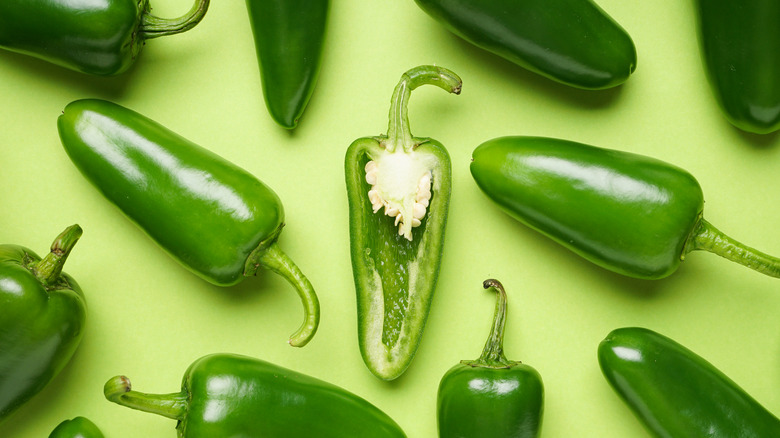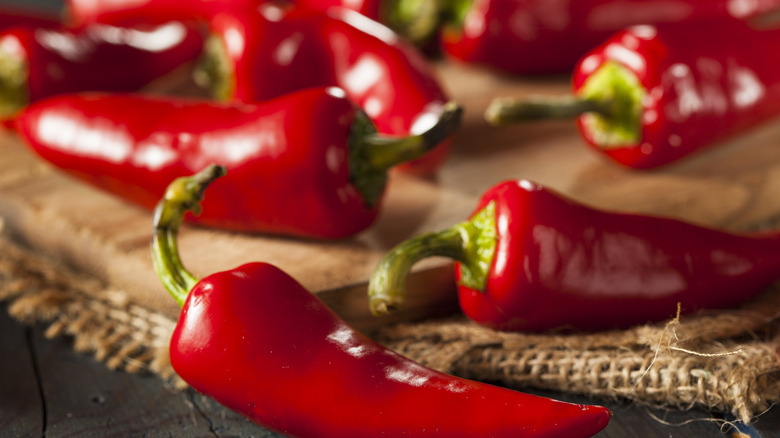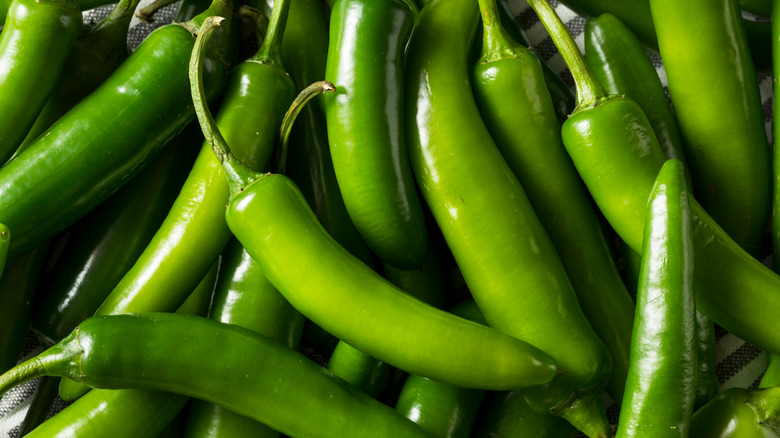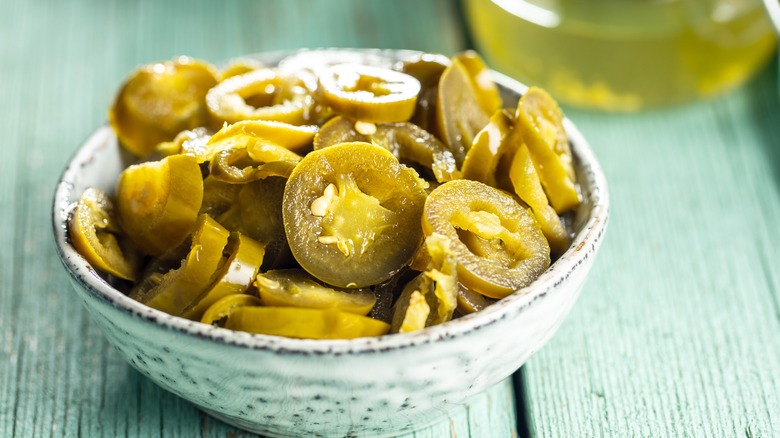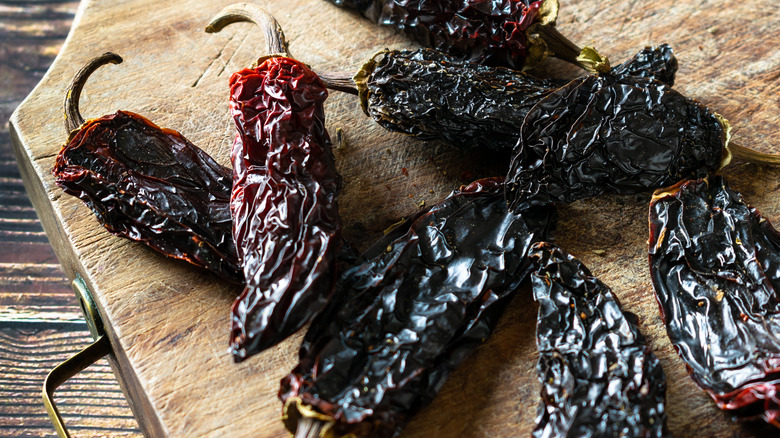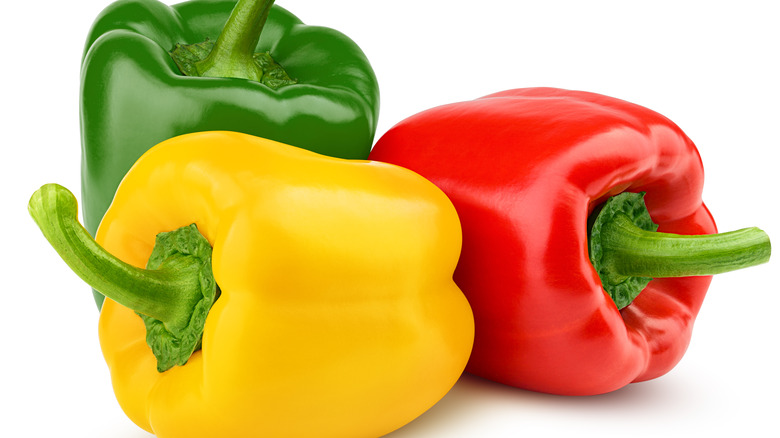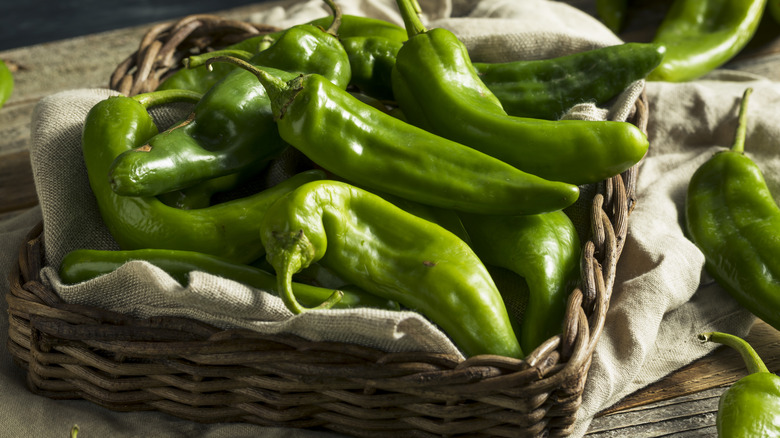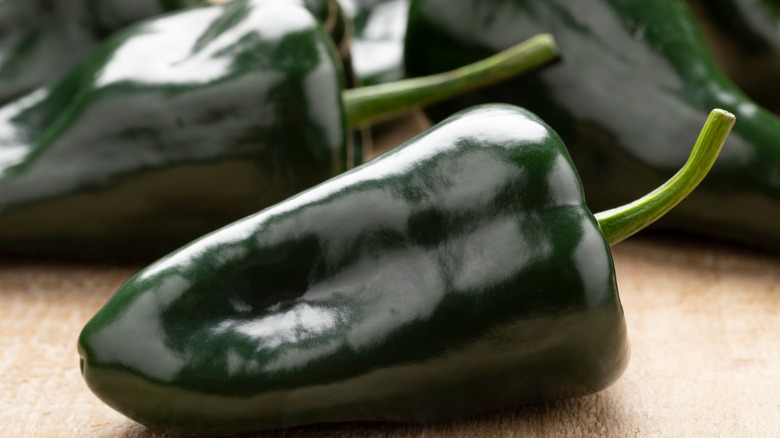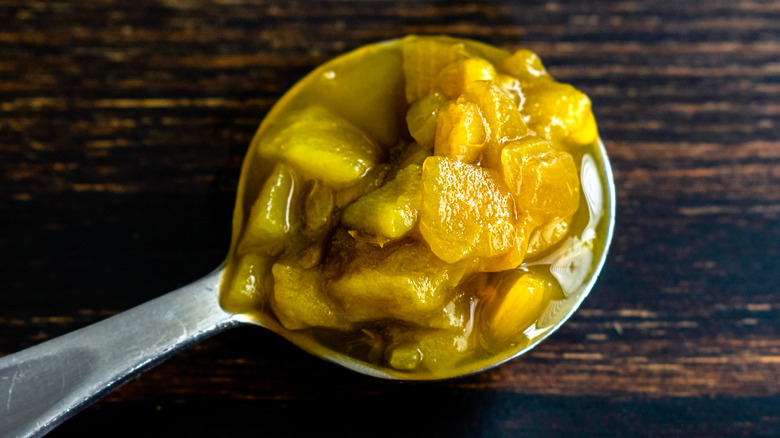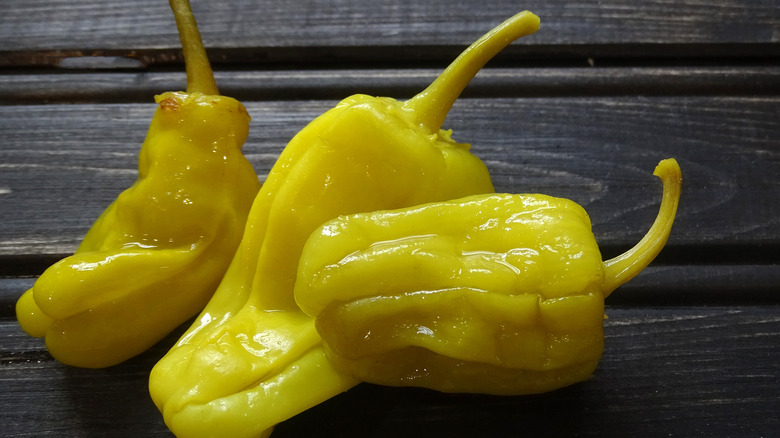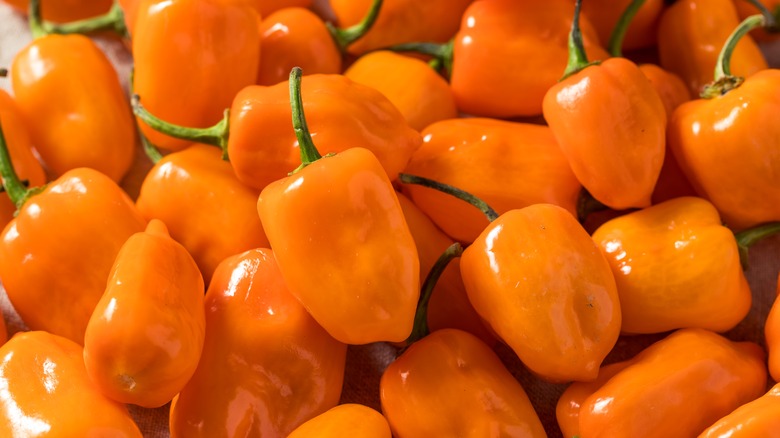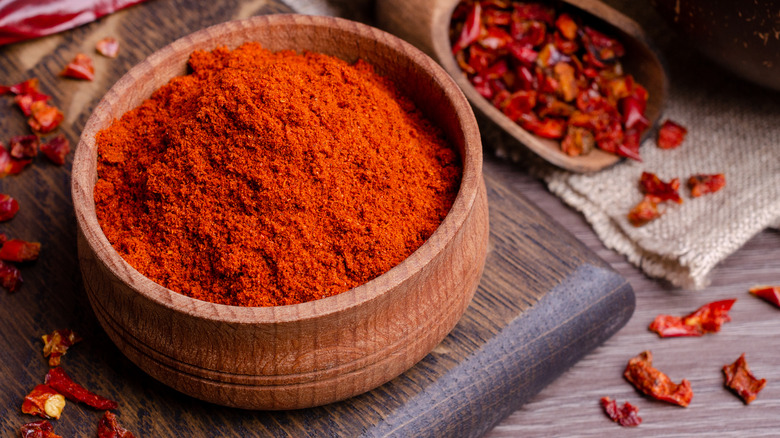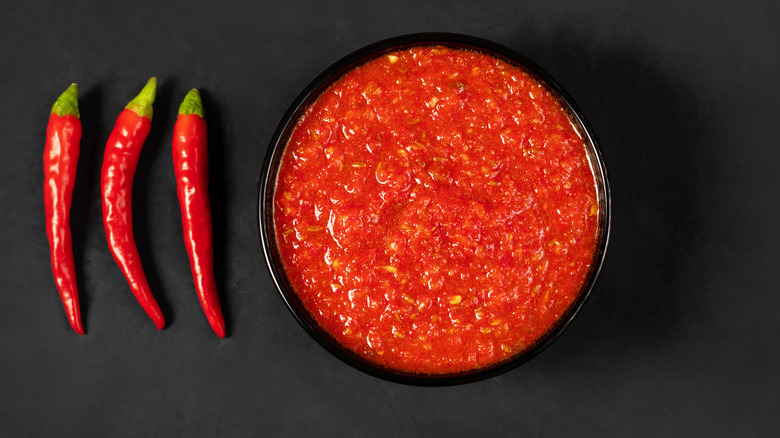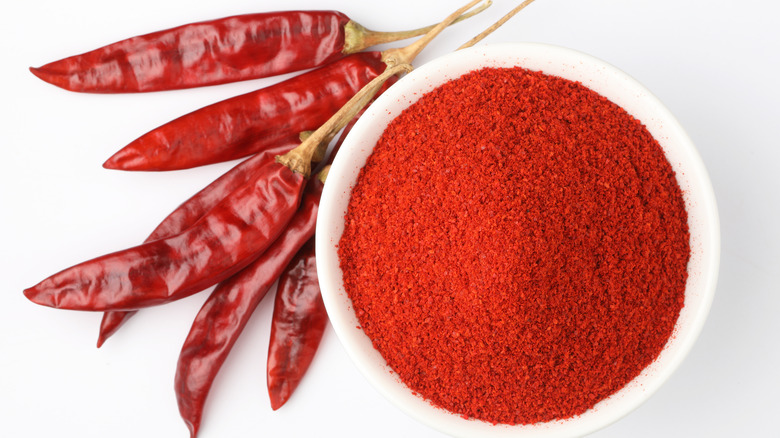The 13 Best Jalapeño Substitutes
Spicy peppers are having their moment in the limelight, from hot sauce brands featuring scary-spicy peppers like Carolina Reaper and Trinidad Scorpion Peppers to baskets filled with habaneros and serrano peppers in the produce section. Despite the widespread availability of more intense varieties, jalapeños remain one of our favorite peppers to cook with.
According to PepperScale, the jalapeño is fairly mild compared to other peppers — only 2,500 to 8,000 on the Scoville Heat Unit (SHU) scale. It's that combination of temperate spice level and a bright, grassy flavor that makes these peppers useful in a wide variety of recipes. Whether it's chopped up in pico de gallo or thinly sliced on top of nachos and tacos, jalapeños simply make everything taste better. Not to mention that it's pretty hard to make jalapeño poppers without using the dish's namesake pepper!
It's usually pretty easy to find jalapeños, but every once in a while, the grocery store does sell out completely (we're looking at you, gameday weekends). For those cases, it's good to have some options for jalapeños substitutes in your back pocket, so that you don't have to ditch your cooking plans.
Fresno peppers
According to Food Source Information of the Colorado Integrated Food Safety Center of Excellence (FSI), Fresno peppers are a common jalapeño variety. That makes these tiny reds our go-to substitute when we can't find the jalapeños called for in our favorite recipe. One of the best reasons to use a Fresno pepper is because it has a similar level of spice. PepperScale has Fresnos listed as 2,500 to 10,000 SHU, which is remarkably similar to the jalapeño.
Although Fresno peppers have a similar size and shape to jalapeños, the two differ in a few key areas. For starters, Freshnos are bright red compared to jalapeños' deep green. While it doesn't affect the flavor or texture of the finished dish, that red color could absolutely make a difference. In a pureed dish like this chimichurri sauce recipe, using red pepper could make the sauce turn out brown instead of vibrant green, ruining the effect. If color matters, it's probably best to use a different substitute.
Serrano peppers
One of the most common substitutes for jalapeño peppers is serrano peppers. This probably has something to do with both fruits being displayed side-by-side at most grocery stores! Over the years, many of you have probably asked yourself if there is even a difference between a jalapeño and a serrano (spoiler alert: the answer is a resounding yes). Serranos have the same color and general shape as jalapeños, but they're longer, skinnier, and also much spicier. PepperScale calls them "the next jump up the Scoville scale," as serranos clock in at 10,000 to 23,000 SHU. As professional pepper pickers (and growers) UCHU report, the ribs and pith are the placentae of a pepper fruit and where most of the heat-inducing compounds are found. With that knowledge, you can cut the peppers in half and remove the inner rib and pith to reduce the level of capsaicin, making your pepper less intense.
Serranos make an excellent substitution for recipes that call for chopped peppers, as that allows you to control the amount you use. You can easily manage the spice level in a recipe that calls for two jalapeños by chopping a half to one serrano instead. That wouldn't be as easy to do with a recipe like a jalapeño popper, though, which requires the use of whole pepper.
Pickled jalapeños
If you can't stand the idea of using a different pepper, you can use a preserved version of jalapeños instead. According to PBS, pickles are made by submerging fruits or vegetables in an acidic liquid (like vinegar) or saltwater brine. These liquids are inhospitable for bacteria, effectively preserving the vegetable inside. Pickles are classically made with cucumbers, but you can also use many other fruits and vegetables, including jalapeños. If you like, you can even pickle your own jalapeños so you'll always have a ready ingredient for a rainy day.
Although food celebrity Andrew Zimmern believes you should never buy pickled jalapeño, sometimes, you just can't avoid it. Store-bought jalapeño pickles are usually pre-sliced, so this substitution only works for recipes that call for chopped or sliced jalapenos. It's also important to remember that the pickling liquid keeps the jalapeño from going bad, but it also changes the pepper's texture and flavor. Pickled jalapeños will still be bold, but the brine imbues a vinegar-forward, acidic finish. That makes them perfect for something like topping nachos, but maybe not as good in cooked dishes like soups or stews.
Despite being a favorite type of pickled vegetable among home cooks (we know, peppers are considered a fruit), jalapeños also lose their crisp finish during the canning process, so the final product will be significantly mushier than the fresh version.
Chipotle peppers
You might be more familiar with Chipotle as a restaurant than an ingredient, but the name first came from a type of pepper. On the substitution front, chipotles totally work as jalapeño replacements because each pepper is actually just a version of the other. When you smoke and dry a jalapeño, it turns into a chipotle pepper. Common information counts these preserved chiles in the Scoville range as jalapeños — 2,500 to 8,00 SHU — so chipotles are a fantastic substitute when it comes to spice level. You might not want to use chipotle peppers if texture and flavor are a major factor, though, as the preservation process expresses a slightly sweet flavor and a lingering taste of smoke.
You may be able to find chipotle peppers at the store labeled as dehydrated peppers, but you can also purchase chipotle paste, dried peppers packed in cans with adobo seasoning, or as a ground powder. Despite similar flavor profiles, there is a difference between canned chipotle and chipotle paste. If you're using the dried peppers, be sure to give yourself enough time to rehydrate them. A little boiling water and about 20 minutes should do the trick. The paste and canned peppers are ready to use, and they're convenient because employing these ingredient doesn't require any prep work. When using chipotle powder, McCormick Spice recommends using ½ teaspoon as a substitute for one large canned pepper.
Bell peppers
According to AgriLife, jalapeños are so closely related to bell peppers that they taste like a green bell with a little extra heat. That makes bell peppers an excellent choice when making a substitution. You'll want to pick a green bell pepper for this swap, as verdant bell peppers have a grassy, vegetal note versus sweet flavors, and the more colorful, different bell peppers (orange, red, or yellow) could ruin the color of your dish. It's also important to know that bell peppers rate a zero on the Scoville scale, so this substitution is more about using pepper with a similar texture instead of using one with a similar spice level.
Bell peppers are also much larger than jalapeños, so you won't want to use the whole fruit in any recipes that call for using whole jalapeños. Instead, seed the pepper and chop it up into small pieces, and you won't notice any textural differences between the two. To amp up the heat of green bell pepper, try adding a spicy powder pepper from this list as well (like chipotle powder, cayenne pepper, or hot paprika).
Anaheim or Hatch peppers
According to Chili Pepper Madness, Anaheim peppers are named after the city that made them a national hit: Anaheim, California. You may also see these peppers in New Mexico, where they're called Hatch or New Mexico chiles. These green peppers have a very similar shape to jalapeños, although they grow a few inches longer, fold near the stem, and have more wrinkled flesh. Anaheims are listed as mild on the Scoville scale, ranking at 500 to 2,500 SHU. That makes the spiciest Anaheim pepper as hot as the mildest jalapeño and a good swap for anyone who doesn't like a ton of fiery heat in their ingredients.
Since these peppers have the same general shape as jalapeños, this would be a fantastic option when making stuffed jalapeño poppers. Anaheims also have thick walls and juicy textures, which adds fantastic utility when chopped up for salsa or thinly sliced for garnishing tacos. If you want to preserve Anaheim peppers as a spice, you'll want to leave the pith and ribs inside the peppers rather than gutting your fruit. Capsaicin is stored in these areas, so this is from where most of your heat will derive.
Poblano peppers
If your grocery store has poblano peppers on the shelves, it will make a fine substitute for jalapeños in most recipes. On the Scoville scale, Poblano peppers are as mild as Anaheim or Hatch peppers at 1,000 to 2,000 SHU (via Healthline). This pepper is less piquant than the mildest jalapeño, so you may want to add some cayenne pepper when using poblanos as a substitution.
Poblano peppers are typically used to make savory, verdant dishes like this chile Rellenos casserole recipe. With that in mind, poblanos are great as stuffed peppers. However, the vegetable would be an odd substitute for stuffed jalapeños recipes since there is such a large difference in size, which could throw off the ratio of stuffing to pepper. Instead, it's better to use poblano in dishes that call for sliced or diced jalapeños. The mild pepper can be enjoyed raw or cooked, used as a garnish, or in pico de gallo. You may find that you love poblano as a substitution since the taste provides a slightly smoky flavor instead of jalapeño's bright, grassy taste, giving the recipe an extra depth of complexity. One of the best uses of poblanos is to add them to cooked dishes for a light touch of pungency, such as in Ina Garten's risotto.
Canned green chiles
Canned green chiles are a fantastic option if you're looking for a substitution that's green and has a mild heat level. Most grocery stores offer a variety of canned diced or chopped green chiles, although it is possible to find whole green chiles if you need them.
It's hard to say exactly what chili is inside the can since the ingredients list keeps it very generic. America's Test Kitchen spoke with Danise Coon, Senior Research Specialist at New Mexico State University's Chile Breeding Program and Chile Pepper Institute, who confirmed that the food packing industry uses the cultivar "Anaheim" to describe a number of different peppers. The exact variety used may affect the flavor and Scoville heat level, which can range from 500 to 2,500 SHU. It was also discovered that cans labeled as "hot" might contain an added heat extract instead of a spicier pepper.
Like the pickled jalapeño substitute, this one is only a good choice if the texture isn't important. These peppers are roasted and skinned before being canned, and the process softens the chilies so that any level of crunch is considerably lost (via New Mexico State University). It's best to use canned chiles as a substitute for recipes that call for roasting jalapeños as part of the cooking process.
Banana peppers
Texas A&M University's AgriLife Extension refers to banana peppers as "sweet frying or pickling peppers," which should give you an indication of this pepper's spice level. Most banana peppers are significantly milder than jalapeños (0 to 500 SHU on PepperScale's hot pepper list), so they're only a good substitute if you want a sweeter, tangier flavor. That said, it is possible to find hot banana peppers (which may be called Hungarian wax peppers). These peppers still have a sweet-tangy finish but blow jalapeños out of the water on the Scoville scale (5,000 to 10,000 SHU).
It may be hard to find fresh banana peppers at the grocery store, but they're almost always available in the pickled goods aisle. These peppers have very thin walls, so flavors are easily soaked up (like pickling liquid). The more delicate flesh also gives them a crisp texture instead of a juicy finish, so banana peppers will eat differently from jalapeños. Before using this as a substitution, keep in mind that a pickled pepper will have a lot more acidity than a fresh jalapeño, too, thus changing the makeup of your dish from something hot to something much more tangy and acerbic.
Habanero peppers
These little, orange, bell-shaped peppers may look harmless, but they pack a lot of heat in a tiny package! AgriLife Today lists these peppers at 100,000 to 400,000 SHUs on the Scoville scale, so the mildest habanero is 40 times spicier than the mildest jalapeño. You definitely wouldn't want to substitute habaneros in the whole form because the result would be much too spicy. Instead, chopping up habaneros and adding the pieces to cooked dishes is the best way to utilize this tiny heater when considering a swap.
The main reason to use habaneros as a jalapeño substitute is for the flavor. When you get beyond the intense aspects, each pepper shares a sweet and fruity character that makes substitution work really well from a taste perspective. Of course, you'll want to tame down that heat as much as possible to make sure you aren't scorching the tongues of guests or yourself with a spice level that is too high. Plan to use fewer habaneros and make sure to remove all the seeds, pith, and ribs when chopping.
Cayenne pepper powder
If you don't need crunchy consistency, but you want to bring the heat, then cayenne powder is an excellent substitution for fresh jalapeños. You may be able to find fresh cayenne peppers at the farmers market, but the powder is easier to find as it's in the spice aisle of nearly every grocery store. Cayenne peppers are significantly hotter than jalapeños (30,000 to 50,000 SHU on the Scoville scale, according to PepperScale). And, in most cases, dried chile peppers are hotter than fresh versions, so you won't need much when using the powder as a jalapeño substitute.
Because the jarred seasoning won't bring any texture to the dish, we love using cayenne powder alongside mild cousin fruits like bell or Anaheim peppers. Since it's been dried and ground, you'll find that cayenne powder is more concentrated than a whole pepper. We recommend being careful when you add it to a dish, starting small with ½ teaspoon and building as needed. You can always add more, but you can never add less!
Hot sauce
There are dozens of varieties of hot sauces, and many are made with jalapeños as their base. When using hot sauce as a substitute, we recommend choosing a picante hot sauce instead of a Louisiana-style hot sauce. There is a nuanced yet clear difference between Louisiana and Picante-style hot sauces. Louisiana-style sauces (like Tabasco) are heavy on the inclusion of vinegar, so the more prominent notes are of a spicy-and-tangy flavor that balances heat with acidity along with a thin consistency. Picante hot sauces (like Cholula) use little or no vinegar, so these sauces contain a pure pepper flavor. Still, picante sauces have a similar viscosity to styles that come from the Gulf Coast.
For the most authentic flavor swap, look for a hot sauce that uses jalapeños as its base. Yellowbird, Cholula Green Pepper Hot Sauce, and El Pato jalapeño are all good choices. Since hot sauce turns peppers into liquid, it's best to use it in soupy or saucy dishes or as a dressing rather than a normal ingredient. You'll also want to remember that hot sauce will have a more concentrated flavor than a fresh jalapeño, too. Like our recommendation for cayenne pepper, you should start small with a ½ teaspoon and taste the dish before adding more.
Hot paprika powder
This isn't our favorite substitution, since paprika has a significantly smokier flavor and lower heat profile than jalapeños. But if you don't have any other options, using paprika powder for jalapeños works in a pinch. According to the University of Illinois Extension, there are three types of paprika power, each depending on the variety of paprika pepper used: sweet, hot, and smoked. Hot paprika would be the best option for your uses since it's the spiciest and least smoky flavored.
SPICEography lists most paprika peppers at around 500 SHU, so the average paprika powder will still be significantly less spicy than jalapeños. That means you'll have to use quite a bit of it to add piquancy to a dish, though adding large quantities of even mild spice powder to a dish can substantially change its eatability. For example, adding a tablespoon of hot paprika might bring extra heat to a soup or stew, but it will also thicken the liquid (via Food Republic). The powder would also change the texture of a fresh salsa like pico de gallo, making it dusty and thick. Because of that, we recommend using paprika powder in recipes that only call for one jalapeño (and don't depend on the texture of a fresh pepper).
